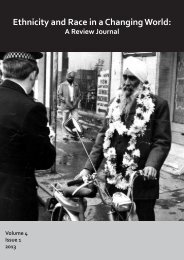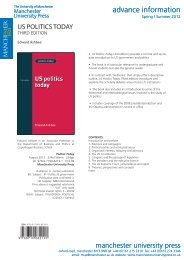Ethnicity and Race in a Changing World
Volume 2, Issue 1, 2011 - Manchester University Press
Volume 2, Issue 1, 2011 - Manchester University Press
You also want an ePaper? Increase the reach of your titles
YUMPU automatically turns print PDFs into web optimized ePapers that Google loves.
<strong>Ethnicity</strong> <strong>and</strong> <strong>Race</strong> <strong>in</strong> a Chang<strong>in</strong>g <strong>World</strong>: A Review Journalthose wear<strong>in</strong>g the clothes themselves to identify what the clothes mean to them <strong>and</strong> what impacttheir dress has on their engagement with public space.The <strong>in</strong>troduction <strong>in</strong>corporates a critique of the dom<strong>in</strong>ance of ‘the veil’ <strong>in</strong> any discussion ofMuslim women, highlight<strong>in</strong>g how many of these discussions are <strong>in</strong>gra<strong>in</strong>ed with b<strong>in</strong>aries of for/aga<strong>in</strong>st,liberative/oppressive, stat<strong>in</strong>g that this book hopes to move beyond this reductive approach. Throughpo<strong>in</strong>t<strong>in</strong>g to the diverse cultural backgrounds of Muslims <strong>in</strong> Brita<strong>in</strong> she highlights the many differentcloth<strong>in</strong>g traditions that have been <strong>in</strong>corporated <strong>in</strong>to fashion trends, that can be called Muslim <strong>and</strong> arethen worn by Muslims from a mix of different cultural backgrounds themselves. As such, Tarlo argues,there are many nuances of visibly Muslim appearances <strong>in</strong> Brita<strong>in</strong> today that are subsumed under thegeneralised term ‘the veil’.Next, Tarlo present three biographies of professional Muslim women – Rezia Wahid, ShaziaMirza <strong>and</strong> Humera Khan - to emphasise the variety of chang<strong>in</strong>g factors that have <strong>in</strong>fluenced theircloth<strong>in</strong>g practices. Through this the chapter <strong>in</strong>dicates the complexity of their stories <strong>and</strong> analyseshow <strong>in</strong>dividual histories <strong>and</strong> experiences become <strong>in</strong>corporated <strong>in</strong>to dress styles.In chapters three <strong>and</strong> four, Tarlo shifts the focus by engag<strong>in</strong>g with a White British convert to Islamwho wears hijab to explore ideas of multiculturalism <strong>and</strong> agency. This chapter also considers howmean<strong>in</strong>gs of the hijab are shaped by conceptual <strong>and</strong> contextual factors such as the ‘war on terror’.The next chapter looks at how young women have experimented with style through <strong>in</strong>corporat<strong>in</strong>gtheir own personal aesthetics <strong>in</strong>to their Muslim dress. Tarlo argues, through referr<strong>in</strong>g to particularcase studies, that look<strong>in</strong>g Muslim is not always a case of conform<strong>in</strong>g to an <strong>in</strong>herited tradition <strong>and</strong> thatMuslim looks can be a way to negotiate multicultural backgrounds. Here she considers <strong>in</strong> detail twoMuslim hip-hop artists called Poetic Pilgrimage.Chapter five looks at the radical political organisation Hizb ut-Tahrir, address<strong>in</strong>g the multipleattempts by media representations, radical <strong>and</strong> conservative Muslim groups, <strong>and</strong> far-right Britishgroups to place women’s dress at the ‘centre of a mythological ‘clash of civilizations’ (p.14). Tarloconsiders her analysis of the media <strong>in</strong> the follow<strong>in</strong>g chapter <strong>and</strong> questions how it is that face-veil<strong>in</strong>ghas become such an emotive issue <strong>and</strong> why it generates such affective responses. She exam<strong>in</strong>es thedifferent mean<strong>in</strong>gs of the niqab through analys<strong>in</strong>g different women’s experiences – both of wear<strong>in</strong>gthe niqab <strong>and</strong> engag<strong>in</strong>g with those who do, <strong>and</strong> looks at onl<strong>in</strong>e discussions. The analysis of the <strong>in</strong>ternetis cont<strong>in</strong>ued <strong>in</strong> chapter seven where<strong>in</strong> Tarlo looks at the website thehijabshop.com <strong>in</strong> consider<strong>in</strong>g therole of fashion commerce <strong>in</strong> underst<strong>and</strong><strong>in</strong>g the visual elements of religion. Next, Tarlo exp<strong>and</strong>s on thisto consider Islamic fashion designers <strong>in</strong> Brita<strong>in</strong> focus<strong>in</strong>g on the role these designers play <strong>in</strong> generat<strong>in</strong>gcosmopolitan fashion for British Muslims by draw<strong>in</strong>g together a multitude of regional global styles.The book is full of pictures to emphasise Tarlo’s po<strong>in</strong>ts regard<strong>in</strong>g the diversity of Muslimimage <strong>and</strong> to highlight the direct engagement she has had with the communities she discusses.The brief afterword highlights how, s<strong>in</strong>ce the manuscript was f<strong>in</strong>alised, she has come across severalblogs <strong>and</strong> onl<strong>in</strong>e fashion stores show<strong>in</strong>g even more shift<strong>in</strong>g styles <strong>and</strong> emphasises that the book’scrucial contribution is to highlight how fluid expressions of Muslim identity are, that fashions are everchang<strong>in</strong>g <strong>and</strong> as such resist reductive generalisations.Also relates to:Arts, Literature <strong>and</strong> SportEconomics <strong>and</strong> GlobalisationHistoryPolitics <strong>and</strong> GovernmentMAKING A NON‐WHITE AMERICA: CALIFORNIANS COLORING OUTSIDE ETHNIC LINES,1925‐1955,Allison VarzallyPublisher: University of California Press, Berkeley, Los Angeles <strong>and</strong> LondonYear: 2008Pag<strong>in</strong>ation: pp. 305ISBN: 978 0 520 25345 2Price: £17.9583






